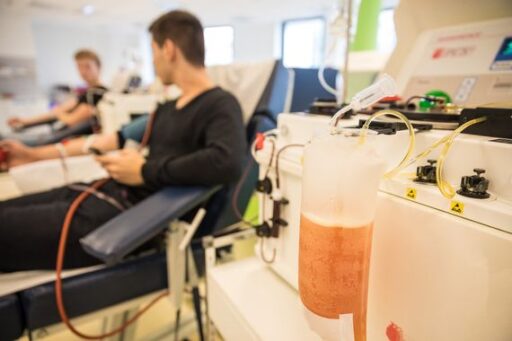March 1, 2023
Providing sustainable access to PDMPs
News
How we provide European patients with sustainable access to plasma products
Pierre Tiberghien, EBA President
Peter O’Leary, EBA Executive Director
Sustainable access to plasma medicines requires a two-pronged approach: an increase in public non-remunerated plasmapheresis programmes, and better knowledge and control over the plasma-to-PDMP-to-patient supply chain.
There is much talk about EU’s dependency on third countries (the US in particular) for the plasma required to manufacture plasma-derived medicinal products (PDMPs). There are two main reasons for this. First, and above all, these plasma medicines are life-saving and critical products which transform the lives of many thousands of Europeans every year. As better diagnostics allow us to identify more people with certain conditions, and as science identifies new usages for PDMPs, there is an increase in demand for the raw material: human plasma, a blood component that cannot be synthetically produced. Patients are justifiably concerned about the continuous availability of these medicines.
The second reason behind the recent interest is that the EU is currently revising its blood legislation and many see this as an opportunity to help reduce this dependency on the US and help secure provision of PDMPs to EU patients.
Improving collection and ensuring a safe and resilient plasma supply system in Europe
Increasing plasma collection is a priority for European public and not-for-profit blood establishments. The European Blood Alliance (EBA) has called repeatedly for European countries to increase public collection of plasma through non-remunerated plasmapheresis programmes. Some member states are already doing it: Denmark doubled its plasma collection in just 8 years. Belgium has a target to increase its plasma collection 5% every year and in 5 years they increased collection by 50%. How did this happen? Political will and commitment. Other countries, including Spain and Italy, are increasingly recognising the urgency of the situation and investing millions of Euro every year, putting similar programmes in place.
The emphasis must be on public, non-remunerated programmes, as they have proven overall more resilient. During the Covid-19 pandemic, countries running public non-remunerated plasma collection programmes had considerably less drops in donations, with some even increasing collections, compared to countries with paid programmes, such as the US where donations dropped 19%[1].
The plasma industry asserts that only by paying donors can Europe collect enough plasma. The principle of volunteer non-remunerated donations has historically prevailed in most of Europe and it is not just an ethical imperative. Plasma donations must be encouraged but we need to move on from the conversation that compensation is a game-changer. In the most recent Eurobarometer on the topic, only 8% of respondents, both donor and nondonor, said they would be motivated to donate by getting something back, where 73-82% are motivated by the desire to help family, friends and others in our communities[2].
Increasing plasma collection is key to the EU but payments to plasma donors erodes the current non-remunerated donor population, which critically ensure the continuous provision of 100% of EU’s need in other blood components and 45% of EU’s plasma, and it can lead to an excessive frequency of plasma donations, which impacts donor health as well as the quality of the plasma collected[3].
To European blood establishments, there is no doubt: building, supporting, and multiplying public non-remunerated plasma collection programmes based on a large and diverse donor base is the best way to build robust supply systems that ensure a sustainable provision of both plasma and whole blood, including in times of crisis.
This revision of the blood legislation is important but far from the silver-bullet on PDMP sufficiency
Increasing plasma collection is only one piece of the puzzle and Europe needs to improve its understanding about what actually impacts patients’ access to PDMPs. The example of the Czech Republic is a case in point: the Czech Republic ranks among the highest EU countries in terms of plasma collection per inhabitant, collecting more plasma than it needs to meet its patients’ PDMP needs. So why then are Czech patients struggling to access PDMPs?
Blood establishments, as plasma providers, and the plasma industry, as plasma fractionators, should be partners to best serve the patients interests. Indeed, the plasma industry plays a critical role in turning plasma from Europe into PDMPs, but these PDMPs usually then enter the world market, like all pharmaceutical products. The current arrangements where pharmaceutical suppliers move medicines toward higher-paying markets mean that a Europe self-sufficient on plasma could still find itself with PDMP shortages if other world regions are willing to pay more for PDMPs made with European plasma. It is therefore fundamental for EU and Member States to have better knowledge and control of the plasma-to-PDMP-to-patient supply chain. Optimising the European plasma-to-PDMPs-to-patients will also better Europe’s position to work with other global regions on ensuring patients there also have their PDMP needs met.
What can Europe do?
EBA has been advocating for an EU strategic approach to reduce dependency on plasma from third countries. Along with other plasma stakeholders, including patient representative groups, we would like to see the future EU regulation mandate the Commission to coordinate a strategy for promoting greater European autonomy in the supply of SoHO with specific targets for SoHO and concrete timeframes to address the patients’ needs.
At the same time, European countries need to improve their knowledge of and control over the plasma-to-PDMP-to-patient supply chain and how it can be improved to better cater to patients’ needs. At EBA we are coordinating a €1.3million EU co-funded project to better understand the whole plasma supply chain, identify bottlenecks, and find ways to tackle them.
Let us then work together to both increase public, non-remunerated collection of plasma and enable a stable and adequate supply of PDMPs to European patients.
[1] https://www.statista.com/statistics/756229/number-of-annual-plasma-collections-in-the-us
[2] EB82.2 Blood and Cell and Tissue Donation BG (EN).xls (europa.eu)

